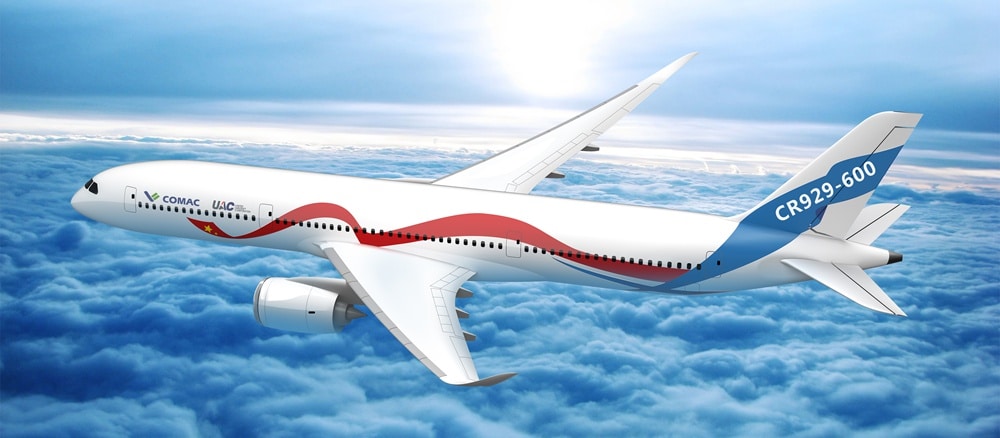Airlines
Russia exits from Comac CR929 program

Russia has withdrawn from the Comac CR929 widebody aircraft project with China, according to the report. it is stated, due to long-term effects from the invasion of Ukraine about 18 months ago. Additional difficulties may be present, according to reported delays for United Aircraft Corp.’s (UAC, Moscow) Irkut (Moscow, Russia) MS-21 single-aisle commercial aircraft. Both aircraft programmes make good use of composite materials.
What Happens When Lightning Strikes an Airplane?(Opens in a new browser tab)
The accuracy of the reports raises intriguing considerations, particularly if one delves into the intricacies surrounding Russia’s sustained participation in the CR929 program despite facing the headwinds of Western sanctions. It is notable that the CR929 programme, a unique joint effort combining the efforts of both China and Russia, has encountered significant obstacles leading to notable delays. Due to these problems, the expected CR929 service launch has been delayed much beyond earlier projections, with a potential post-2030 schedule now being considered.
The lengthy negotiations over the division of labour and the complex sharing of intellectual property rights have been crucial in causing these delays. The continuation of the China-Russia Commercial Aircraft International Corp. (CRAIC), a company founded in 2017 and profiting from China’s moderated stance towards imposing sanctions on Russia, is an important aspect in this scenario.
Singapore Airlines Axes Vancouver Flights, Exits Canada(Opens in a new browser tab)
Yury Slyusar, CEO of United Aircraft Corp. (UAC), recently announced widely that UAC was leaving the CR929 joint venture. Although a decision has been made, it will probably take some time to detangle the agreements between the Russian and Chinese governments in order to cancel the joint venture.
Uncertainties concerning the participation of Western suppliers arise from the complex nature of collaboration, integration, and information exchange in aircraft programmes. Initially, it was anticipated that Western experts would contribute to a number of systems in the CR929 project.
The CR929 is a long-range, wide-body twin-engine aircraft developed by China’s COMAC (Commercial Aircraft Corporation of China) and Russia’s United Aircraft Corporation (UAC). The CR929 aspires to compete in the lucrative market for big passenger planes with major aircraft manufacturers such as Boeing and Airbus. With a passenger capacity ranging from 258 to 320 passenger , the CR929 was created with an outstanding range of up to 12,000 kilometers with consideration.
Similar to the CR929 programme, the MS-21 (or MC-21) programme has experienced delays as a result of the withdrawal of Western suppliers.This Russian-backed project had ambitious aspirations to roll out an astonishing count of 270 units by the time 2030 arrives, with an initial projection of the deployment of MC-21 aircraft by 2024. Due to the significance of this situation, Russian manufacturers have been given more time to properly swap out imported actuators, avionics, and air conditioning components with domestically sourced replacements.

Airlines
Sanctions & Engine Issues Ground Half of Russia’s A320neo fleet

Russia’s aviation sector, already strained by Western sanctions, faces another setback as nearly half of its Airbus A320neo family aircraft are grounded due to unresolved engine issues.
This development highlights the growing challenges for russia commercial aircraft in maintaining their fleets under the weight of global restrictions and limited access to spare parts.
Out of the 66 Airbus A320neo and A321neo jets in Russia, 34 are now out of service, according to the Kommersant business newspaper. These planes are powered by engines manufactured by Pratt & Whitney, a subsidiary of RTX Corporation.
DAMAC Air: Dubai’s New Luxury Airline Offers Free Flights for Registration
The engines are affected by a previously identified defect in the metal used for certain parts, prompting accelerated inspections and maintenance.
Sanctions have compounded the issue, blocking the supply of essential components from major manufacturers like Boeing and Airbus. Without proper maintenance, experts warn that these aircraft may face decommissioning as early as 2026.
COMAC Unveils Plans for the C929 to Rival Airbus and Boeing
Airlines like S7, which operates a significant portion of these grounded jets, plan to conserve the engines for future use during peak travel seasons. However, reports suggest that over 20 of S7’s Airbus planes have engines that have already reached the end of their operational lifespan. Recently, russia seeks assistance from kazakhstan’s airlines to bolster its domestic flights.
While some A320neo and A321neo planes in Russia are equipped with French-made LEAP engines, which are seen as less problematic, the challenges remain daunting.
The situation underscores the long-term impact of sanctions on Russia’s aviation sector and the increasing difficulties in keeping its modern fleets operational.
-

 Aviation2 months ago
Aviation2 months agoMicrosoft Flight Simulator Raises $3 Million to Bring Back the An-225 Mriya
-

 Airlines2 months ago
Airlines2 months agoQantas Engineers Stage Walkout Over Cost of Living Concerns
-

 Airlines2 months ago
Airlines2 months agoQatar Citizens Can Travel to the United States Without a Visa
-

 Aviation2 months ago
Aviation2 months agoQatar Airways bans these new Electronic Devices on plane
-

 Airlines2 months ago
Airlines2 months agoJapan Airlines Rolls Out Free Domestic Flights to International Passengers
-

 Defence2 months ago
Defence2 months agoWhich Country Has the Largest Fleet of Fighter Aircraft?
-

 Airport2 months ago
Airport2 months agoWestern Sydney Airport Welcomes Its First Plane After 6 Years of construction
-

 Aviation2 months ago
Aviation2 months agoDid you know ? Once Boeing 747 carried 1088 passenger in 1991








